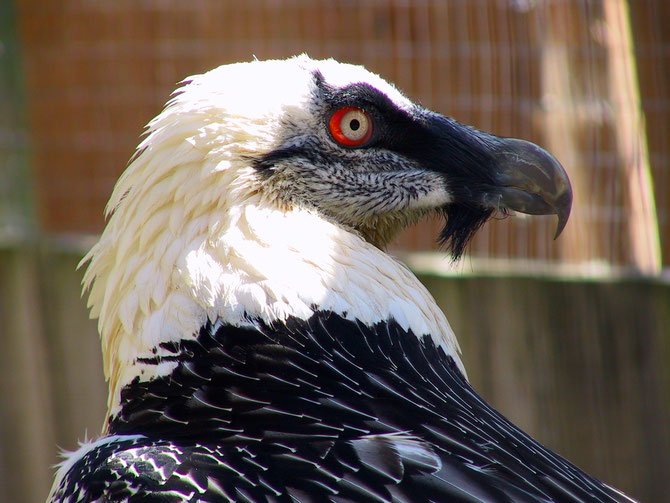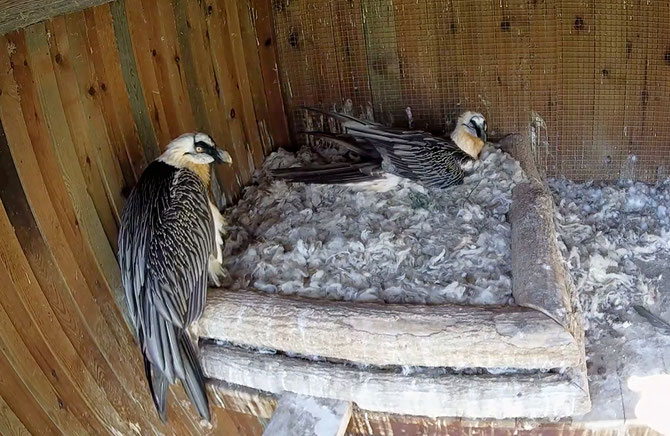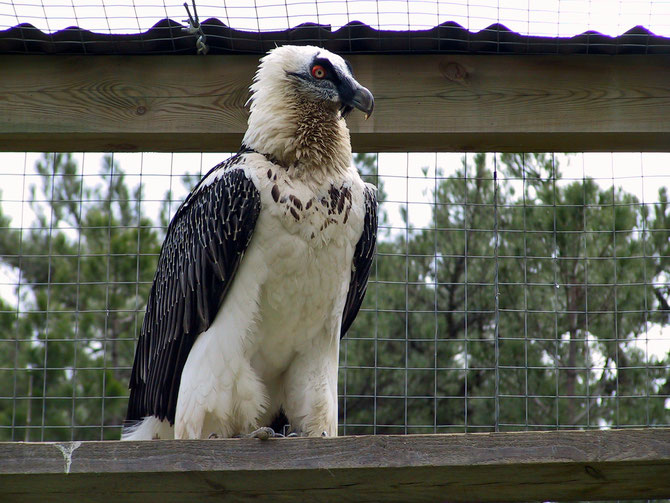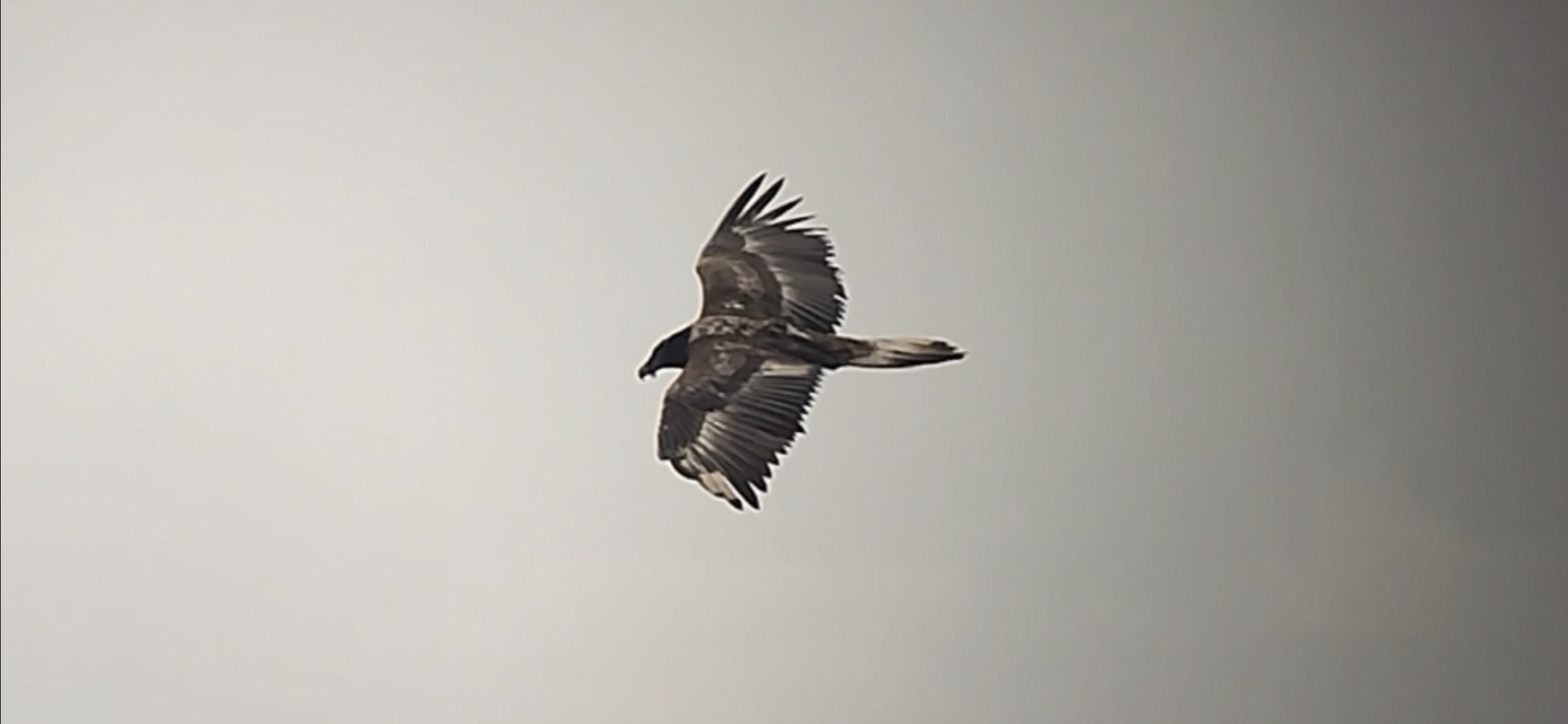
It is with a heavy heart that we announce the death of Bearded Vulture Dama (BG103) that passed away last week on Friday, 11 December 2020, during the night. Dama was a wonderful breeding female that has left a legacy behind. She was the second most productive Bearded Vulture female within the Bearded Vulture Captive Breeding Network, coordinated by the Vulture Conservation Foundation (VCF) on behalf of EAZA‘s EEP (Bearded Vulture EEP). She played a vital role in the pan-European efforts to reintroduce the species in areas where it disappeared and was also responsible for securing an important genetic line. Dama was one of the descendants from the only male in captivity from Crete in Greece. Furthermore, her partner, Tejo, is a descendant from the last alive Bearded Vulture individual from the Balkan Peninsula, therefore, the loss of Dama also caused the loss of a ‘power couple’.
Dama’s aggressive behaviour led to a new pair-bonding technique
Dama hatched at the Richard Faust Bearded Vulture Specialised Captive Breeding Centre in Austria (RFZ) on 7 March 1988. Her Father, BG065, came from Crete and her mother, BG040, was a descendant from the old La Garenne breeding pair BG034 x BG035.
At the early stages of her life, there was a mistake in Dama’s sex determination and she was considered male, and was housed with another male until 1992 when she was not of breeding age. Following that, they paired her with a female until 1995. Because of their behaviour, they tested her sex again, and they discovered she was female.
The Network then tried to pair her with four different adult males between July 1995 and November 2003 but with no success. She was a very aggressive bird, and she would not accept pairing with adult males, so the Network decided to take another approach. They tried a new pair bonding technique, to pair her with a young bird still in dark plumage. This method was implemented thanks to the observed behaviour of released birds in the wild, where juvenile birds were always dominant to adult birds when feeding, which was concluded in the thesis of Alex Llopis, VCF’s Vultures Captive Breeding Manager and the Coordinator the Bearded Vulture EEP. Now the Network continues to use this technique when dealing with difficult and aggressive birds.
Dama finally accepts a partner named Tejo

When Dama met Tejo, she finally met her match. There was quite a big age difference between the two, as Tejo hatched in 2001 and Dama in 1988, but it worked. As a young bird, Tejo was dominant, and she finally accepted a male partner!
Still, there were still quite a few issues that followed after she started laying eggs. She was very nervous when she laid a clutch and buried most of her eggs under the wool, which threatened the chances of a chick hatching. So, her human keepers removed her clutches and incubated them by other pairs. In the following years, her clutches were then artificially incubated, thanks to a method developed by the VCF, at the Bearded Vulture Specialised Breeding Unit within the Centre de Fauna de Vallcalent, managed by the VCF under an agreement with Generalitat de Catalunya.
Additionally, she didn’t adopt chicks, so it was impossible to use her as a foster female to rear her own or other chicks. Thanks to human intervention, the pair has produced a total of 24 fledglings in the past 13 breeding seasons. Sixteen of them have been released into the wild as part of the ongoing reintroduction efforts in Europe. The other eight became part of the Bearded Vulture EEP. Only one of her descendants is successfully breeding in captivity today, currently housed at RFZ, managed by Hans Frey. Another one has already produced a clutch, the other four are mating, and two are still waiting for male partners, so it looks that we will secure the special genetic background of Dama and Tejo.
Dama’s sudden death
The VCF staff at Vallcallent noticed something was wrong with the female Bearded Vulture and started continually monitoring her behaviour. Suddenly, her health deteriorated. The team further noticed that the bird was not eating well and examined her, realising that she was losing weight fast. They then urgently searched for a vet clinic with the capacity to perform an endoscopy on a Bearded Vulture and came across Anadón Vet Clinic, which also generously carried out the procedure for free. But, the endoscopy, as well as the X-rays, did not reveal anything abnormal. In the meantime, the team started treating the vulture based on her symptoms. Alex Llopis, who is also a veterinarian, was also in contact with colleagues in Austria and elsewhere discussing Dama’s health, but the prognosis seemed bleak. In her last days, she became weaker and less active, but was still mating and nest building until 6 December and copulating until 9 December. After doing everything in our power to save the bird, she, unfortunately, died on 11 December 2020, leaving behind her partner and a great legacy. The necropsy revealed that Dama suffered a perforation of the duodenum just after the stomach. The cause is unknown, as theoretically bones should not pass the pylorus and perforate the intestine wall.

We are deeply saddened with the loss of Dama, but today, we want to celebrate this incredible bird’s long life. We will always remember her for what she taught us about her species and of course, for her important contributions to the conservation of the Bearded Vulture in Europe.
Donate to the VCF and contribute to the comeback of the Bearded Vulture in Europe.







